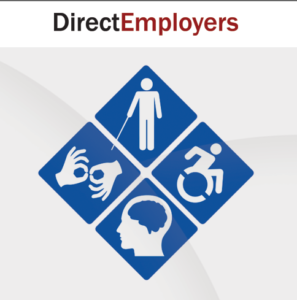The following post was authored by Brett Sheats and is being shared with permission from our partner, the Employer Assistance and Resource Network on Disability Inclusion (EARN).
I had the great opportunity to attend the U.S. Business Leadership Network (USBLN) national conference, an annual meeting of companies with a demonstrated commitment to a disability-inclusive workplace. As always, the event was a very fitting prelude to National Disability Employment Awareness Month.

USBLN members are among those already reaping those benefits, on multiple levels. A large percentage are federal contractors covered by Section 503 of the Rehabilitation Act, and not surprisingly, many are also members of DirectEmployers. After all, disability is a critical component of workforce diversity. Reflecting this, the theme for this year’s NDEAM celebration is #InclusionWorks.
I just love that theme, because it encapsulates in a nutshell the simple but significant message that we at the Employer Assistance and Resource Network on Disability Inclusion (EARN) promote each day. We know from research that diverse groups—those representing a range of perspectives—are more productive than non-diverse groups with similar skills. As one of the nation’s largest minority groups—approximately 56.7 million individuals, according to 2010 census data—people with disabilities are obviously important to have represented at the table. Their perspective is vital to best serve a large part of any business’s consumer base.
But, even if companies understand that #InclusionWorks, not all may know how to effectively recruit people with disabilities. The key is workplace policies and practices that promote equality and full access for all qualified individuals. In addition, there are many avenues for proactive recruitment, including building relationships with workforce development service providers, such as vocational rehabilitation agencies and American Job Centers, as well as Centers for Independent Living and other community-based organizations.
Another strategy that resounded loudly at USBLN was the value of taking steps to proactively attract students and recent college graduates with disabilities just starting out in their careers. Internships have proven a great strategy in this regard, because so many interns return to their host employers following graduation. And when they do return, onboarding is smooth, because they’re already familiar with company systems and culture. Thus, for federal contractors, welcoming interns with disabilities can be a highly effective strategy for advancing long-term goals under Section 503.
To recruit interns with disabilities, employers nationwide can take advantage of the Workforce Recruitment Program, a free resource for identifying highly motivated, pre-screened students and recent graduates with disabilities seeking both internships and permanent employment in a variety of professional fields. Through the program’s portal, WRP.jobs (itself a collaboration between EARN and DirectEmployers) employers can post permanent and temporary positions. In turn, WRP participants (and only WRP participants) can search and apply for these positions using employers’ standard application processes.
Another great resource is Career Opportunities for Students with Disabilities (COSD). COSD also assists employers in identifying qualified college students and recent graduates with disabilities seeking internships or permanent employment through a variety of activities nationwide, including “Full Access” summits and career fairs.
Employers, especially small businesses, may also benefit from thinking locally. One easy approach is for employers to reach out to local college and university disability student service offices to let them know they particularly welcome applications from qualified students with disabilities. They can also ask to be informed about any upcoming campus career fairs or other opportunities to meet with potential hires.
Of course, inclusive recruitment is only one component in fostering a disability-friendly workplace. Employers must also take steps to ensure new hires with disabilities can thrive once on board. Furthermore, they must ensure that existing employees who may acquire disabilities, including age-related disabilities, have the supports they need; doing so is essential to corporate continuity. A great resource in this regard is the Job Accommodation Network (JAN), which provides free and confidential guidance on workplace accommodations.
Across the employment lifecycle, this month and every month, inclusion works, helping employers not only attract a wider pool of talent, but also retain the talents of an aging workforce. In honor of this year’s NDEAM theme, employees and employers across the U.S. are encouraged to reinforce this by posting images illustrating inclusion at work in their workplaces, using the hashtag #InclusionWorks. I look forward to the conversation, and encourage all DirectEmployers members to join in!
Brett Sheats currently serves as the National Project Director for the National Employer Policy, Research and Technical Assistance Center for Employers on the Employment of People with Disabilities. The Employer TA Center, through its website AskEarn.org, acts as a resource for employers looking to recruit, hire, retain, and advance individuals with disabilities.
Prior to this role, Brett was a manager with Wounded Warrior Project’s Warriors to Work program. The program helped post-9/11 veterans dealing with injuries or illnesses from their time in service find employment and build careers. Brett has also worked as a finance attorney with the firm of Schulte Roth & Zabel LLP in New York, NY, and is a United States Army veteran of the war in Afghanistan.
Brett is a graduate of The George Washington University Law School and Wake Forest University. He originally hails from Camp Hill, Pennsylvania and currently lives in Washington, D.C.

